Products
the latest products to help you improve your manufacturing process
Lucid Triton2 2.5GigE Camera Family
Lucid Vision Labs, Inc. announced the expansion of its Triton2 camera series featuring the latest Sony Pregius S sensors with a 2.5 GigE interface.
The Triton2 camera family utilizes Sony’s Pregius S global shutter CMOS image sensors, offering a diverse range of resolutions from 1.6 MP to 24.5 MP. With this expansion, Lucid introduces four new Triton2 camera models that have now entered series production. The image sensors in these models include the 1.6 MP Sony IMX273 running at 166 fps, the 2.3 MP IMX392 at 116 fps, the 5.0 MP IMX264 at 35 fps, and the 12.3 MP IMX304 at 22 fps. Additional models are planned for release later this year.
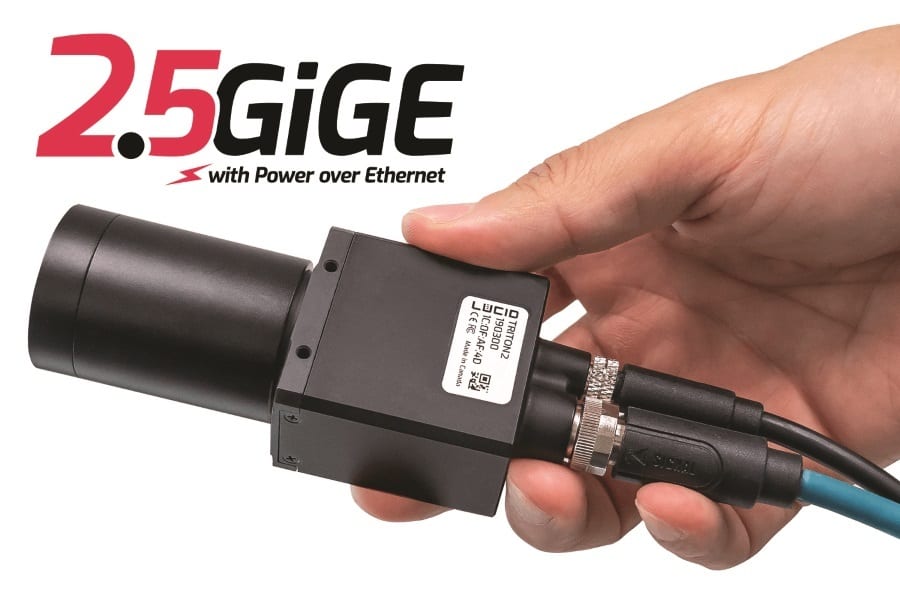
Triton2 leverages Lucid’s trusted Factory Tough™ industrial platform, delivering unparalleled performance within a compact, cost-effective, and uncompromising camera design. The adoption of the 2.5GigE (300 MB/s) interface enhances bandwidth, while retaining the benefits of a compact size, efficient thermal management, and Power over Ethernet (PoE) support.
Designed for seamless integration, the 2.5GBASE-T Triton2 enables rapid data transfer rates of 300 MB per second and supports standard CAT5e and CAT6 cables up to 100 meters.
All Lucid cameras conform to the GigE Vision 2.0 and GenICam3 standards and are supported by Lucid’s own Arena software development kit. The Arena SDK provides customers with easy access to the latest industry standards and software technology. The SDK supports the Windows, Linux 64-bit and Linux ARM operating systems, and the C, C++, C# and Python programming languages.
LUCID Vision Labs, Inc.
www.thinklucid.com
Pleora AI Inspection, Checklist Capabilities for Vaira Manufacturing Platform
Integrating inspection and checklist apps with new AI object detection and classification skills reduces quality escapes and improves traceability for manufacturers.
Pleora Technologies expanded its scalable suite of shop-floor ready AI and digitization apps for its Vaira solution to help manufacturers automate and upgrade error-prone processes. Built on Pleora’s 23-plus years of expertise in industrial automation, Vaira integrates machine vision cameras, lighting, edge processing, manufacturing system connectivity, and a low-code development platform with a suite of customizable shop-floor ready inspection and traceability apps.
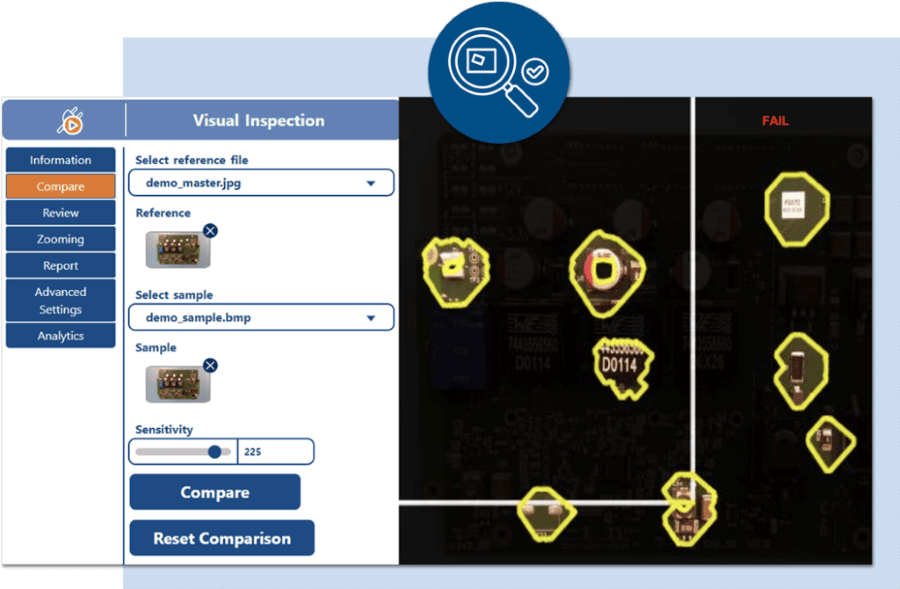
Expanding the capabilities of the solution, Vaira’s visual inspection app now includes AI-based object detection and classification skills that can be integrated with assembly checklist and work instructions. With Vaira’s new inspection and checklist app, an electronics manufacturer has reduced final verification steps from over four minutes to 30 seconds. Vaira has also been deployed in electronics assembly, recycling sorting, and automotive, medical, utility and small parts manufacturing applications.
With Vaira’s combined inspection and checklist features an operator follows digitized instructions that clearly guide product assembly step-by-step, while AI and machine vison automatically verifies quality. For example, the app can check that the correct component has been used as part of an assembly and confirm that it is in the proper position. If a defect is detected the operator can’t move to the next assembly step until the error is corrected. Adding product tracker app capabilities, product images and operator notes are captured and stored to a manufacturer’s ERP/MES system for compliance, traceability, and continuous improvement initiatives.
Pleora Technologies
https://www.pleora.com/digitize-manufacturing/
Emergent Vision Technologies eCapture Pro Software
It now supports GPUDirect, H.265/H.264, and RTMP streaming.
Emergent Vision Technologies announced that its eCapture Pro software now supports GPUDirect, H.265 and H.264 video codecs, and RTMP (real-time messaging protocol) streaming. These additions further strengthen the software’s ability to enable the most challenging high-speed imaging and machine vision applications with no data loss.
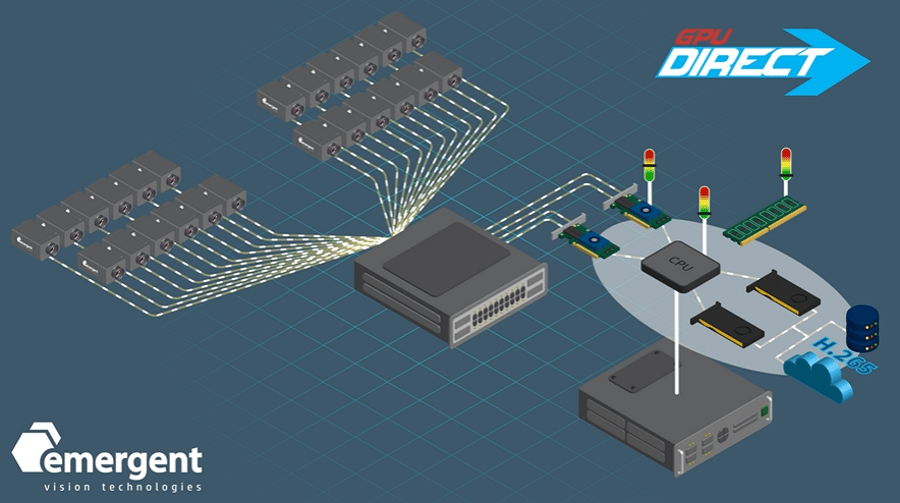
Emergent’s eCapture Pro software offers an intuitive graphical interface for complete and easy system integration, camera setting flexibility, advanced preview and recording, and synchronized capture to microsecond accuracy, as well as calibration, background, and production-take management capabilities. In addition, the software enables the use of the industry’s fastest frame rates. With support for GPUDirect — a capability that passes data straight from a camera to a GPU, bypassing CPU and system memory — eCapture Pro can help remove the overhead and latency involved with making memory copies.
Once data passes from the camera to a GPU, the now-supported H.265 and H.264 video codecs can compress the images. H.265, the successor to H.264, delivers up to 50% better video compression while maintaining the same level of video quality, making it an ideal option for high-speed, high-resolution video. Compatible with both H.265 and H.264, RTMP enables users to stream high-speed video to YouTube and other live streaming platforms.
In a real-world example involving H.265 recording and RTMP streaming, 24x 25GigE Bolt HB-12000-SB machine vision cameras featuring the 12MP Sony Pregius S IMX535 sensor were deployed along with a midrange server and CPU, 24-port switch, two dual-port 100GigE network interface cards (NICs), and two NVIDIA GPUs. Using GPUDirect technology and running at 60 fps, camera data is sent directly to the two GPUs, which perform H.265 compression. Compressed images are stored locally on a disk and streamed via RTMP to YouTube. Running at 30fps, the system can support as many as 48 cameras using a 48-port switch while still running on a single server and CPU.
Emergent Vision Technologies
www.emergentvisiontec.com
Lucid RDMA Integration for Atlas10 Cameras
Lucid Vision Labs, Inc., announced the integration and availability of Remote Direct Memory Access (RDMA) data transfer technology across its complete range of Atlas10 – 10GigE cameras.
Lucid’s award-winning Atlas10 camera featuring RDMA provides optimized, zero-copy image transfer over a 10GigE interface. The Atlas10 with RDMA reliably streams 1.2 GB/s of data directly to main memory, bypassing the CPU and OS. This increases throughput, lowers latency, and eliminates CPU usage, which are required for reliable multi-10GigE camera applications. Lucid’s RDMA implementation includes an updated Arena SDK version featuring RDMA support, a complimentary RDMA firmware upgrade for all existing Atlas10 camera models, and a selection of two compatible, cost-effective dual port 1G/10G PoE+ RDMA-enabled network interface cards.
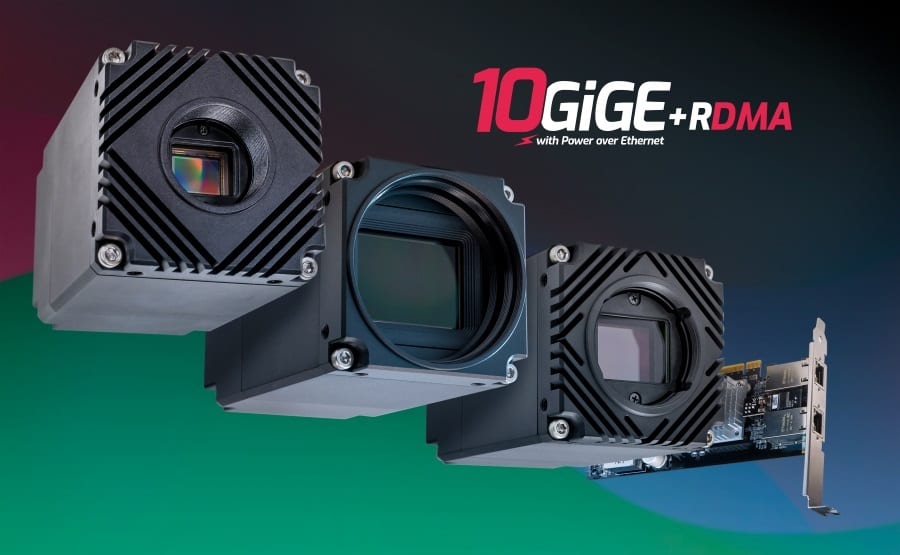
The Atlas10 10BASE-T camera is known for its industrial reliability offering Power over Ethernet (PoE+), robust M12 and M8 connectors, Active Sensor Alignment for superior optical performance, and a wide ambient temperature range of -20°C to 50°C. The Atlas10 is a GigE Vision and GenICam compliant camera with data transfer rates of 10 Gbps that can use standard CAT6 cables up to 25 meters. Atlas10 also features Power over Ethernet (PoE+) which simplifies integration and reduces cost.
As an active member of the GigE Vision standards committee, Lucid supports the integration of RDMA technology into the next release of the GigE Vision standard. Lucid believes standardization of RDMA technology will accelerate the industry adoption of faster Ethernet transfer rates such as 10GigE, 25GigE and beyond.
The RDMA-enabled Atlas10 – 10GigE cameras and a selection of two compatible, cost-effective dual-port 1G/10G PoE+ network interface cards are now available to order. Additionally, the latest Arena SDK and firmware versions with RDMA support can be downloaded for immediate use.
Lucid Vision Labs, Inc.
www.thinkLucid.com
Nikon Metrology Wafer Automatic Measurement Solution
The Industrial Metrology Business Unit of Nikon Corporation has released the automatic wafer measurement system NEXIV VMZ-NWL 200 to solve the challenges of wafer metrology in the semiconductor back-end process, where more work is traditionally carried out manually than in front-end process control. The main target market for NEXIV VMZ-NWL 200 is therefore measurement centered on semiconductor manufacturing processes in the back-end.
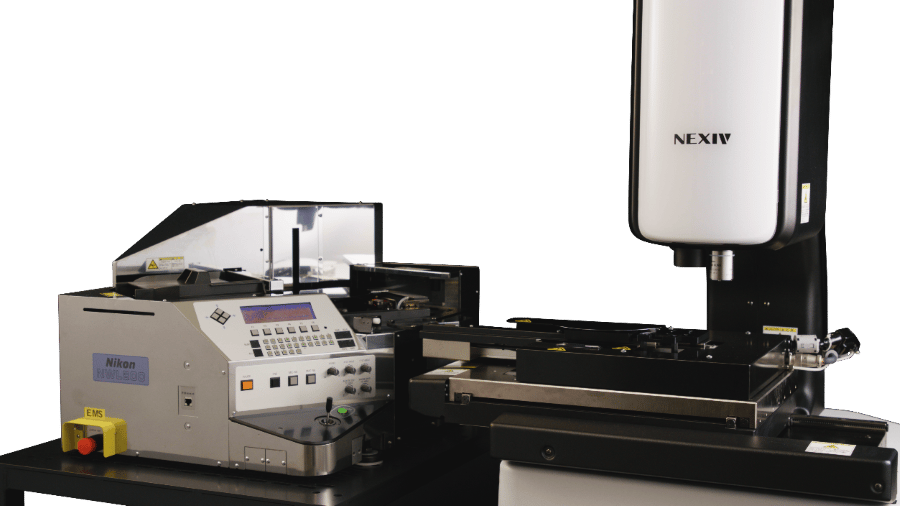
NEXIV VMZ-NWL 200 alleviates the shortage of skilled technicians for manual measurement. The semiconductor industry has developed along the path of miniaturization, which has increased the skill level required for measurement and reduced the number of available engineers. On the other hand, the semiconductor market continues to expand so the increasing metrology opportunities are being offered to ever fewer people. As a result, manual measurements using conventional optical microscopes have reached their limits.
NEXIV VMZ-NWL 200 is a system that automatically measures 6-inch or 8-inch wafers held in a carrier according to a measurement program. High repeatability of measurement is ensured by the reliability of the NEXIV and stable wafer loading using the NWL. The system allows intuitive selection of the chip to be measured using dedicated software. Therefore, anyone is able to achieve the chip measurement results they need with a high degree of reliability. In addition, it is possible to trace when the measurement was performed and by which program, helping to improve traceability.
The system is designed with safety in mind and a protective cover is provided to prevent possible damage due to operator error. Operation meets SEMI international standards S2, S8, and F47.
Nikon Metrology
www.industry.nikon.com
Verisurf RPS Alignment Functionality
Verisurf Software, Inc., announces new RPS (Reference Point System) Alignment functionality added to its popular 3D metrology software. This new alignment capability was a popular request from Verisurf customers and is essential for automotive manufacturers to ensure precise alignment throughout the manufacturing process. With the new Verisurf RPS Alignment, aligning parts to CAD using defined reference points is faster and more efficient than ever. Verisurf RPS Alignment seamlessly connects measurements to defined reference points with precise control, streamlining the quality verification workflow.
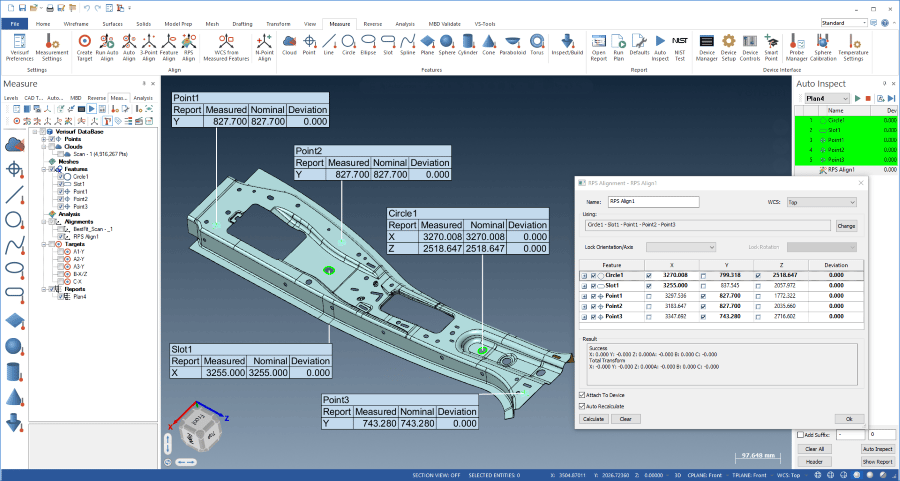
RPS alignments play a critical role in industries like automotive, stamping die, aircraft engines, and power generation, ensuring precise alignment of points and features on different part types to defined reference points. Verisurf RPS Alignment unites the powerful capabilities of Auto Align and Feature Align within the software. This innovative integration furthers Verisurf's commitment and dedication to industry support, automation, and process improvement.
Verisurf's RPS Alignment enables users to align parts effortlessly using measured points, features, and surface points. This versatility allows for easy alignment to virtually any datum scheme, facilitating effective planning and execution of alignment procedures while reducing errors and enhancing overall efficiency.
According to the company, Verisurf is the only measurement, reverse engineering, and inspection software built on a full-featured 3D CAD/CAM platform with intelligent Model-Based Definition (MBD). This ensures data integrity and enables users to perform metrology workflows in a seamless CAD environment while maintaining model-based digital continuity. Verisurf software is compatible with all CAD file formats, and the Verisurf Device Interface (VDI) communicates with and operates all 3D measurement devices for universal compatibility. Verisurf's modular design enables users to quickly shift from reverse engineering to inspection to tool building, efficiently capturing and processing measurement data for all 3D metrology applications with repeatable process control across the manufacturing enterprise.
Verisurf Software, Inc.
www.verisurf.com
Renishaw Industrial Automation Products
Renishaw unveils a new product line specifically designed for the industrial automation market. The new RCS product line builds on its existing expertise and technologies for industrial metrology applications and aims to transform the process of commissioning and servicing industrial automation technologies. Developed to solve some fundamental challenges within the global industrial automation industry, the new RCS product line focusses on the problems associated with manual set-up, calibration, and maintenance of robots, such as operational accuracy and repeatability.
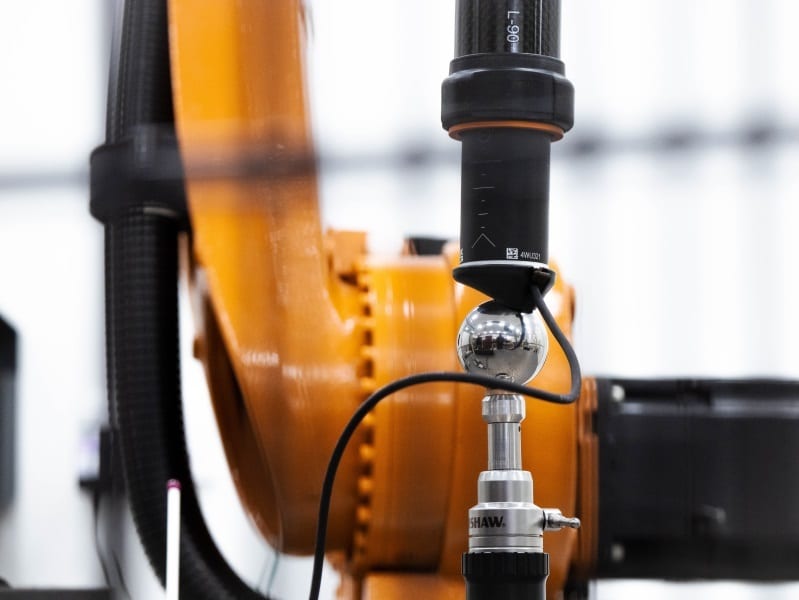
The range includes three products: RCS L-90, RCS T-90, and RCS P-series, all supported by a dedicated software suite. RCS L-90 is a ballbar device that improves robot system accuracy, reduces deployment time, and monitors robot health with simple routines controlled by its supporting software suite. RCS T-90 is a tri-ballbar system which enables robot users to identify root causes of poor performance, with further comprehensive tests to capture critical robot information – such as remastering the joint offsets to calculated positions, running master-recovery routines, and plotting 3D path performance. The third RCS product, RCS P-series, integrates a permanent Renishaw probing solution within a robot cell to apply in-process metrology and automatic recovery to automation processes.
Built upon established and trusted Renishaw technology, this new product line for industrial robotics brings the company’s metrology expertise to an industry that has significant challenges with performance accuracy and repeatability. Categorized as either ‘in-field’ or ‘in-process’ products, the new RCS products help to simplify robot set-up, health checks and recovery of robotic applications following collisions. Working with Renishaw’s new intuitive robotics software, RCS Software Suite, the products support robots from a wide range of manufacturers.